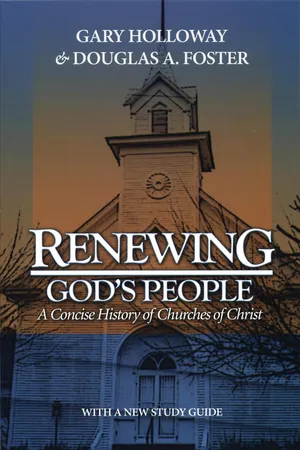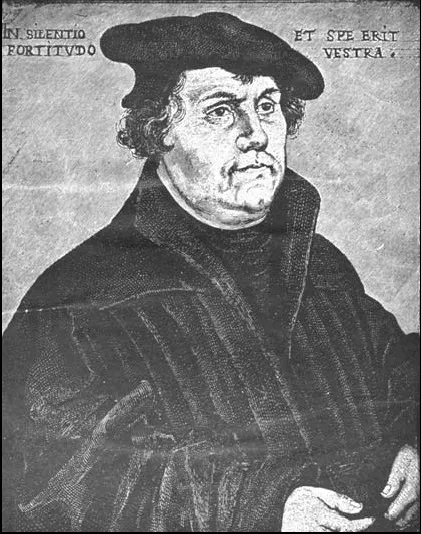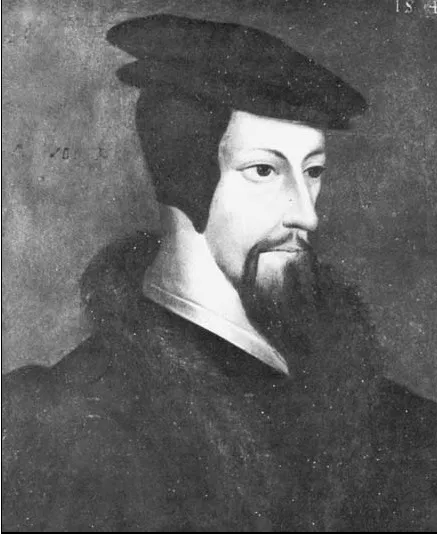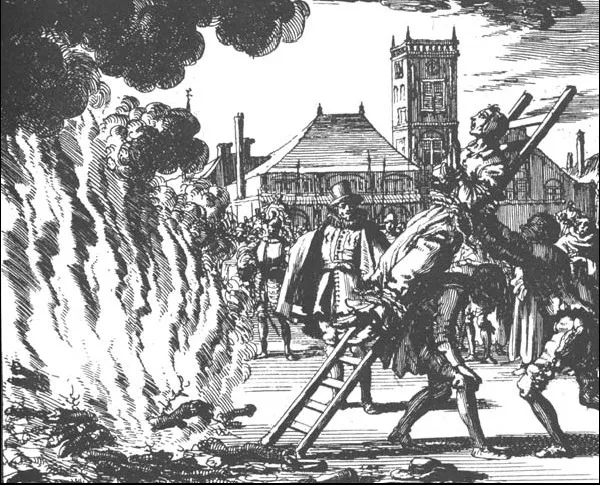CHAPTER 1
Do We Have a History?
He came into a course in Restoration History and announced, “I don’t care what Barton Stone or Alexander Campbell said. All I care about is what the Bible says.”
We thought of several appropriate responses. What we did say was, “At least one reason you care only for what the Bible says is that Barton Stone and Alexander Campbell influenced you.”
Or take another example. An undergraduate Bible major goes home to visit. At church on Sunday, a good deacon asks him, “What are you studying this semester?” The student replies, “The Gospel of Luke, Youth Ministry, Speech Communication, English Composition, and Restoration History.” “Restoration History?” the deacon replies. “What good will that do you?”
These stories illustrate the mixed feelings in Churches of Christ about our history. Indeed, some would deny that we have a history. Aren’t we the church of the first century? Isn’t all church history after the first century just a record of apostasy and corruption? Shouldn’t we leap over those years to the purity of the early church? Don’t we undercut our plea to be biblical by admitting we have a history?
Many Birthdays
We understand those who want to deny our history. On the side of the church building where one of us grew up were the words: “Church of Christ, Established A.D. 33.” The idea was that we wanted to be the church of the New Testament, the one established at Pentecost. That ideal still burns brightly in our hearts. We do not want to restore everything about the early church (no one wants to be exactly like the Corinthians), but we do want to be the kind of church that the first century churches should have been. In a real sense, we can trace our existence to that first church at Pentecost.
But do we have a history after Pentecost? Honesty requires that we answer, “Yes.” The whole history of the church, as messy and fallen as it has been, is in some sense our history. Although we want to be like the early church, we must admit that we are not the first Christians. Two thousand years have passed. Previous generations have passed the faith on to us. We would not have the Bible itself were it not for the faithful labors of copyists and translators who lived long after Pentecost. One reason for studying church history is to honor these spiritual fathers and mothers.
Studying church history also helps us experience how faithful Christians in the past struggled to follow God in their own context. If we can see how the church in the past often conformed too much to its culture, then perhaps we can see how our own culture threatens to subvert the current church. Studying church history also shows how the church has positively affected the culture around it.
Studying history can also help us understand the Bible. We prize the authority of the Bible because those who went before us taught us to respect it. By seeing how previous generations understood (and misunderstood) the Bible, we gain a perspective on its meaning for our time.
This book focuses on our history in the context of America. While it is true in one sense that Pentecost A.D. 33 (or more likely, A.D. 30) is our birthday, there are other dates we can point to as beginning points of the existence of Churches of Christ in America. The first “founding document” of our history is The Last Will and Testament of the Springfield Presbytery written in 1804. The ministers who wrote those words began the first group of independent churches in this movement. Although many before him called Christians back to the Bible for the sake of Christian unity, Thomas Campbell’s publication of The Declaration and Address in 1809 marked a significant intellectual beginning to our movement. The Disciples of Christ in particular see that date as their starting point (see chapter four), celebrating a centennial in 1909 and anticipating a bicentennial in 2009.
At the end of the nineteenth century, the movement divided with the Disciples of Christ (Christian Church) and Churches of Christ becoming separate groups. Some place that division in 1889, when Daniel Sommer and others called for a break of fellowship in the “Address and Declaration” at Sand Creek, Illinois. The “official” date of that division is 1906 (see chapters eight and nine). Thus, in one sense, Churches of Christ in America will have our centennial in 2006.
So what is our birthday? All and none of the above. We do want to be the church founded at the first Pentecost after the resurrection of Jesus. Yet, we must admit that we are the church in an American context. We owe our identity to Thomas Campbell, Alexander Campbell, and Barton Stone in the 19th century. We also owe a debt to those in the 20th century who shaped what we now are as Churches of Christ.
Tradition and Traditionalism
The student and the deacon mentioned above reflect our longstanding opposition to tradition. Why should we study our history if we in Churches of Christ have always been against tradition? Shouldn’t we be like that student who rejected Stone and Campbell to go to the Bible alone? The answer to these questions lies in the distinction between “tradition” and “traditionalism.” Historian Jaroslav Pelikan has defined tradition as “the living faith of the dead,” and traditionalism as “the dead faith of the living.”
The Bible is both positive and negative about tradition (the biblical word means simply “something passed down”). When tra- dition becomes traditionalism, that is, when it takes the place of the original intent of God, then it deserves condemnation. Both Jesus (Matthew 15:1-6) and Paul (Colossians 2:8) condemn human traditions that supersede the will of God. On the other hand, Paul many times urges the churches to “hold on to the traditions” he had taught them (1 Corinthians 11:2; 2 Thessalonians 2:15; 3:6). These were not mere human traditions, but were the word and will of God.
So why study the history of Churches of Christ? To honor our spiritual ancestors who passed the tradition of the faith on to us. Yet, those traditions must always be subject to the authority of Scripture. Indeed, one of our strongest traditions is the ultimate authority of the Bible over tradition. Nevertheless, responsible traditions are necessary to give shape to our church life and to help in passing on the faith. Indeed, church traditions are inevitable. The alternative would be starting the church over anew each day, resulting in chaos. Those traditions become harmful only when they change into fixed traditionalism that leads us away from the clear intent of Scripture.
In other words, denying we have a history leads to danger. Failure to recognize that our history shapes us results in our being prisoners to it. By being blind to the historical forces that shape our church practices, we fall prey to the danger of mistaking our circumstances and conclusions with the eternal will of God. By denying we have a history, we easily become traditionalists like the Pharisees who equated their teachings with God’s Word.
We write this brief history as loyal members of the Churches of Christ. We are proud to belong to this movement. If we deny the good our spiritual ancestors accomplished, we become ungrateful children. If we ignore their mistakes, we become traditionalists who prize our own human history above the will of God. Only by taking an honest look at who we have been can we understand who we are. God has given us the ability to think historically and to grow in our understanding through this powerful gift. Using this gift of historical sense wisely is part of being faithful to God in our time and place.
The Early and Medieval Church
Acts chapter two portrays the first church in Jerusalem as a model church. They listened to the apostles, prayed, shared their food and money, grew numerically and had harmony with those around them (Acts 2:42-47). The rest of Acts and the New Testament, however, make it clear that the first century church had its problems. Individual congregations like Corinth faced divisions. The Judaizers claimed another way of salvation (Galatians 1:6-9). Others claimed a special knowledge unavailable to most (Colossians 2:16-23). Some even claimed to be Christians while denying that Jesus had come in the flesh (2 John 7). Even in the best of churches, there were those who did not get along (Philippians 4:2).
Thus, from the beginning church history has been messy. On the one hand, the church is a divine institution, the blood-bought bride of Christ. On the other, it consists of redeemed people who are still human, flawed, fallen, and sometimes even apostate. Although Jesus prayed that believers would have unity (John 17:20-23), from the very beginning of the church that unity has been a struggle.
During the first century of the church, the apostles were there to give guidance and direction. Their teaching and writings gave shape and unity to the churches. This is why it is right for us in Churches of Christ to hold up the first century church as a model. They were not a perfect church, but they were apostolic. We want to be the ideal church we see modeled in the life of the apostles and other faithful New Testament Christians. We want to follow the apostolic teachings of the New Testament.
By the second century, however, the apostles were gone. The books of the New Testament existed, but the church had not yet collected and recognized them as Scripture (that process happened slowly over the next two centuries). One force that continued to give the church cohesion was the persecution of Christians by the Roman Empire. Although the persecution was sporadic and usually local, it did help keep the church pure. One did not become a Christian to get ahead in society. Instead, the examples of noble martyrs gave courage and boldness to the church.
That all changed at the beginning of the fourth century. A new emperor, Constantine (274-337), won his crown in battle after appealing to the Christian God. Although he tried to please both pagans and Christians as emperor, he eventually became a Christian and began the process of making Christianity the state religion.
Obviously some good resulted from Constantine’s decision. The government no longer jailed, tortured, and killed Christians. The empire eventually ended slavery and protected human rights. Tragically, however, the power structure of the empire soon dominated the church. Over several centuries, the medieval Roman Catholic Church developed an elaborate system of penance that included belief in purgatory, the intercession of saints, and the power of the priest to absolve from the temporal punishment of sin.
In spite of all the developments away from the simplicity of the New Testament, we do owe considerable debt to the medievalchurch. They kept alive the gospel story. They preserved the manuscripts of the New Testament. Although corrupt in many ways, they were the church for centuries.
The Reformation
Even during the Middle Ages, some attempted to reform the church, with varying degrees of success. By the sixteenth century many more wanted reform, including Martin Luther (1483-1546), a German monk and theologian. The heart of his theology was justification by grace through faith, in contrast with the Roman Catholic practices of his day that implied people could merit salvation. Luther also called the church back to the authority of the Bible, wanting sola scriptura, “Scripture alone” as his guide. He never intended to form a new church, but eventually his followers were excommunicated by the Roman Catholic Church and formed a separate body.
In Switzerland, a more thoroughgoing Reformation took place under Huldreich Zwingli (1484-1531) at Zurich. Though his career was brief, Zwingli began the “Reformed” tradition, the second major Protestant movement after Lutheranism. John Calvin (1509- 1564) in Geneva later became the chief influence in this Reformed Church. Calvin’s emphasis on the sovereignty of God led him to emphasize the doctrine of predestination. This doctrine still shapes the churches of the Reformed tradition such as Presbyterians and many Baptists.
A third branch of the Reformation was the Anabaptist or Radical Reformation. Some considered these Christians “radical” because they insisted on a stricter return to the teaching of the New Testament, believing the pacifism Jesus taught on the Sermon on the Mount was crucial to a true Christian life. They also insisted on believer’s baptism, thus earning themselves the name Anabaptists (“rebaptizers”) from those who practiced infant baptism. This meant a break with the union of church and state that Constantine had established centuries before. Almost every government in Europe, whether Catholic or Protestant, viewed their refusal to baptize infants as a threat to the social order. Consequently, Anabaptists faced severe persecution. Since most of them were pacifists, they refused to resist the government violently. Consequently, many fled to Holland where there was some degree of religious tolerance.
We in Churches of Christ owe a great debt to the Reformation. Barton Stone, Alexander Campbell, and other leaders in Churches of Christ often praised Luther and Calvin for their work in leading people back to the Bible. Indeed, they saw their task as finishing the work of Reformation begun by Luther and others, often calling their work, “the Current Reformation.”
England and Scotland
Since most of the early settlers in Britain’s American colonies came from England and Scotland, the reformation in those countries had a more direct effect on Churches of Christ in America. In England, prompted by personal, political, and religious problems, King Henry VIII (1491-1547) broke from the Roman Catholic Church in 1534 to form the Church of England. Of all the Reformation churches, this Anglican Church made the least changes from Catholic practices.
Consequently leaders arose who, influenced by the Reformed Church teaching of John Calvin, desired more reform in the Church of England. Their attempt to purify the church led to their being called Puritans. Some despaired of ever changing the Church of England and separated from it to form their own pure churches. These Separatists faced persecution in England and so some fled to Holland, then to America, becoming the Pilgrims of Plymouth Plantation.
Other Separatists organized themselves under groups of elders or presbyters. Through the leadership of John Knox (1513-1572) in Scotland, this Presbyterian system became the official Church of Scotland. Still other Separatists in England began to practice believer’s immersion, and so became known as Baptists.
Members of all these groups—Anglicans, Puritans, Separatists, P...




